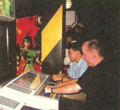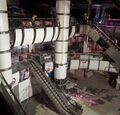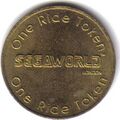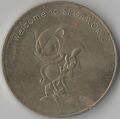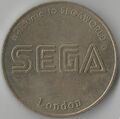Difference between revisions of "SegaWorld London"
From Sega Retro
(fixed spelling mistakes, incorrect facts, better wording, added more images.) |
m |
||
| Line 26: | Line 26: | ||
===Level 3: Flight Deck=== | ===Level 3: Flight Deck=== | ||
| − | This floor contained 20 "flying" games, and the | + | This floor contained 20 "flying" games, and the [[VR-1|VR-1 Space Mission]] ride. It also featured [[Dennou Senki Net Merc|Sega Net Merc]] and [[R-360]] machines, the former having been originally located on the Combat Zone floor at launch. |
The Flight Deck floor housed the first commercially available ex-RAF Harrier Jump Jet, having been towed through London on a boat in the months prior to opening{{magref|cvg|177|8}}. | The Flight Deck floor housed the first commercially available ex-RAF Harrier Jump Jet, having been towed through London on a boat in the months prior to opening{{magref|cvg|177|8}}. | ||
Revision as of 10:55, 29 October 2019
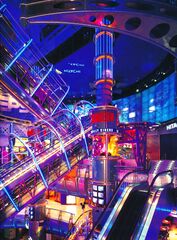
|
| SegaWorld London |
|---|
| Location: The Trocadero, London, United Kingdom |
| Google maps: 51.510490,-0.133022 |
| Opened: 1996-09-07[1] |
| Closed: 1999 |
This teeny-tiny article needs some work. You can help us by expanding it.
SegaWorld London was a Sega World indoor theme park which opened on September 7, 1996. It was housed within the London Trocadero complex within the city of London, UK. Upon launch, the Trocadero site became the flagship Sega World site in Europe, building on earlier success seen at Sega World Bournemouth. It was also the largest indoor arcade on the continent, occupying an area of 10200m² on seven floors[2] but has since closed its doors permanently.
Contents
Layout
SegaWorld London was a six-floor indoor arcade with seven medium-scale rides. While often billed as an indoor theme park, much of SegaWorld's attraction was its numerous arcade machines, including full-size 8-player iterations of games such as Daytona USA, and import titles rarely seen in the UK. It was also used, similar to Sega World Bournemouth, for location testing Sega arcade machines.
SegaWorld London originally charged a flat rate at the entrance, which would cover all the rides. This was replaced with a free entry system, where visitors would have to pay for each individual ride. At no point where the arcade machines themselves free play - most operated on a token system.
From the entrance, SegaWorld London would lead visitors up the "rocket escalator" (16.43m in length (with 80m of handrail), 31.5 tons in weight and 193 steps[3] (although it was technically two escalators, not one)) to the sixth "level" (floor), before leading down each level to the exit.
Level 6: Reception
Starting at the top, visitors could pay for ride tickets on this level and try a selection of free Sega Saturn consoles. Also housed on this level was the first ride, the Beast In Darkness motion simulator.
Level 5 : Combat Zone
This floor had no rides, but over 50 action games, including Virtua Cop 2 and Fighting Vipers, as well as non-Sega titles like Time Crisis and Area 51.
Level 4: The Race Track
This floor featured over 70 racing games, most notably two back to back 8 player deluxe setups of Daytona USA and Manx TT Superbike. One of Damon Hill's FW15C racing cars from the 1993 Formula One season was also featured on this as a photo opportunity. During that season, Damon Hill drove with Alain Prost for Williams, who were sponsored by Sega at the time (incidentally Prost was used to advertise the Sega arcade at La Tête Dans Les Nuages in France around this period). The ride on this floor, Aqua Planet, was a 3D motion simulator.
Level 3: Flight Deck
This floor contained 20 "flying" games, and the VR-1 Space Mission ride. It also featured Sega Net Merc and R-360 machines, the former having been originally located on the Combat Zone floor at launch.
The Flight Deck floor housed the first commercially available ex-RAF Harrier Jump Jet, having been towed through London on a boat in the months prior to opening[4].
Level 2: The Carnival
This floor was very large, containing over 80 arcade machines (mainly prize redemption + UFO Catcher machines), a McDonalds outlet, the "Segakids" indoor play area, and 3 rides; Power Sled, House of Grandish and Ghost Hunt.
Level 1: Sports Arena
The final floor, Sports Arena, had 90 sports games (including Virtua Striker and Sega Bass Fishing), the Sega Store, and the rides Mad Bazooka (removed after 1998) and a AS-1 Motion Simulator.
History
Development
The Piccadilly Trocadero was originally built in 1896 as a restaurant, before closing in 1965. It re-opened as an entertainment and shopping complex in 1984. By the 1990's, the lower floors were home to numerous VR experiences, a Guinness World Records tourist attraction, and Alien War, a themed walkthrough attraction based on the Alien films, but it was still struggling to find tenants to fill the large space above them. In 1994 it was purchased by Burford Group plc, led by Nick Leslau and Nigel Wray, who endeavoured to revamp the site for modern consumers.
At the same time, Sega, fresh from arcade and console video game successes, were making moves in opening Sega-branded arcade centres across Europe. In the case of the United Kingdom, this began with Metropolis in late 1992 and continued with the likes of Sega World Bournemouth and a handful of smaller venues using the "Sega World" name. Sega was itself one of the biggest brands in the UK at the time, riding on the successes of the Sega Master System and Sega Mega Drive (and particularly Sonic the Hedgehog), and was attempting to open new arcade centres in the region every couple of months.
Sega had already had enormous success in Japan following a similar concept. In particular, the 1994 launch of Joypolis Tokyo was proving to be very lucrative - effectively an indoor theme park, Joypolis took things one step further by housing indoor rides and large scale attractions, and still remains active to this day. The plan was to emulate this idea in other parts of the world, so Sega Europe arranged with Burford Group to build SegaWorld London - a UK version of Joypolis.
Construction began in early 1996 on a planned £45 million project encompassing 100,000 square feet of the Trocadero site (covering seven floors), aiming to be the largest indoor theme park in the world. As well as housing seven dedicated indoor rides, many of its floors would be devoted to arcade machines, and would become a new testing site for Sega's own arcade releases in the years which followed.
Opening
SegaWorld London opened on 7 September 1996, amid mass hype and promotion created by Sega in magazines, including Sonic the Comic. Right from the outset, there were already clear problems. The opening day press event was a PR disaster, with hour long queues for most rides, and customers being unimpressed with how simple and uncreative some were. On top of the £12 entry price, every individual arcade machine had to be paid for, and any food and drink had to be purchased from the onsite McDonalds outlet or food stalls- none was allowed to be taken in. This made for an overall negative feeling in reviews of the place, with most being mixed at best. Additional controversy was made over Sonic The Comic printing apparent free entry tickets for the park, only for them to be turned away after admission attempts.
From 1996, Pepsi sponsored the Trocadero, as well as funding its Pepsi Max Drop Ride (1998) and IMAX cinema (1997), being the first 3D IMAX cinema to appear within the UK; however, these deals were with the Trocadero itself and did not benefit Sega directly, although Pepsi vending machines and drinks could be found inside of SegaWorld itself. [5]
Sega had hoped to attract 1.7 million visitors to the facility during its first full year of operation in 1997, but achieved just 950,000. Entry fees were scrapped to attract additional footfall, but this did little to turn the situation around. Sega's ten-year deal with the Trocadero included a three-year early termination clause if £3 million profit was not achieved [5], and this was exercised in 1999 against a backdrop of major losses at the company. The floors were sublet to Family Leisure, operators of numerous arcades in London, including Funland, which was situated just below SegaWorld in the Trocadero building.
Demise
In the years that followed the site was stripped down considerably- Pepsi turned their sponsorship offline, closing the IMAX theatre and renaming the Pepsi Max Drop to "London's Scream Ride". The physical Pepsi Max Drop ride itself was then later sold and moved to Funland Hayling Island, an unrelated amusement park based on Hayling Island, in 2003. Family Leisure co-joined their two preexisting Funland floors to the former 6 of SegaWorld, and ran the place as a large Family Entertainment Centre, instead of the theme park model intended by Sega. Most of the Sega-era features were taken out and replaced with new attractions intended to broaden the appeal of the centre, including a bowling alley, sports bar, and fairground rides, though decor from the old themes was still visible in some of the upper floors. A new facade was also constructed to the right of the Trocadero's central atrium, featuring new balconies and neon signs.
However, Funland's operators, Family Leisure, were not used to running an arcade of its size, having only dealt with much smaller locations in its past. Floors were often understaffed, leading to ongoing crime and antisocial behaviour issues with visitors, worsening the public's view of the place. This and the increased dominance of consoles over arcades made management come to the decision of blocking off access to the upper 5 floors of the Trocadero, stopping and cordoning off the rocket escalator that went to them with it (although it took until May 2011 for it to be physically removed). At no point was the complex significantly revamped, meaning traces of the SegaWorld layout and closed rides still existed for much of the decade. The first Rocket Escalator still remained to take visitors up to Funland, where a walk way had been made to join the 2nd floor up to the midway podium between the two escalators.
Despite finding success in dance/rhythm arcade games like Dance Dance Revolution and Pump It Up during the 2000's, Funland began to decay, and ceased trading in July 2011 after unpaid bills and an acrimonious dispute with the Trocadero's new owners, Criterion, who planned to convert the building into a hotel. Most of Funland's machines were sold off to other nearby arcades, like Las Vegas Arcade in Soho and The Heart Of Gaming in Acton. Any remaining unsold cabinets were both moved in front of Funland's intact and shuttered entrance on the first floor and to the Trocadero's basement for two makeshift arcades, rumoured to be on a 2 week contract period with free rental, giving 70% of their earnings from the machines to Criterion in return. The other Rocket Escalator that headed up to Funland was removed in the process.
The final traces of SegaWorld were removed from the venue in 2014. That February, Criterion ordered all tenants besides the entrance way shops and Cineworld out, closing off the central atrium for construction works, closing the two basement arcades and removing most of the final remnants of decor from the SegaWorld era in the process. A few leftover arcade machines remained in a corridor made for Cineworld to continue trading, as well as a visible entrance to where Funland was, until it too closed down in September, and was revamped into a new Picturehouse Cinema.
Gallery
Merchandise
Magazine articles
- Main article: SegaWorld London/Magazine articles.
Promotional material
External links
References
- ↑ File:CVG UK Freeplay 07.pdf, page 1
- ↑ Press release: 1996-09-12: INTERNATIONAL MANAGER : Sega Tests the Theme-Park Route
- ↑ Computer & Video Games, "June 1996" (UK; 1996-05-09), page 57
- ↑ Computer & Video Games, "August 1996" (UK; 1996-07-11), page 8
- ↑ 5.0 5.1 Marketing Week: Sega makes a play to win back top UK slot
| Sega-related venues in the United Kingdom |
|---|
| Sega World |
| Bournemouth (1993-2000) | London (1996-1999) | Tamworth (199x-xxxx) | Wolverhampton (199x-xxxx) | Birmingham (199x-xxxx) |
| Sega Park |
| Glasgow (1993-200x) | Acton (1994-199x) | Colindale (1994-2008) | Southampton (1996-2013) | Wood Green (199x-xxxx) | Basildon (199x-2005) | Reading (199x-199x) | Bristol (199x-200x) | Harlow (1997-2003) | Tower Hill (xxxx-200x) | Harrow (200x-200x) | Holborn (200x-200x) | Brighton (2002-2006) |
| Sega Zone |
| Brixton (199x-xxxx) | Catford (199x-xxxx) | Woolwich (199x-xxxx) |
| Sega Megaworld |
| Croydon (199x-199x) | Harrow (199x-199x) | Romford (199x-199x) |
| Sega Prize Zone |
| West Midlands (2015-2020) | Southport (2016-2019) | Hatfield (2016-2020) |
| Others |
| Metropolis (1992-199x) | Planet Sega Queensway (199x-200x) |






